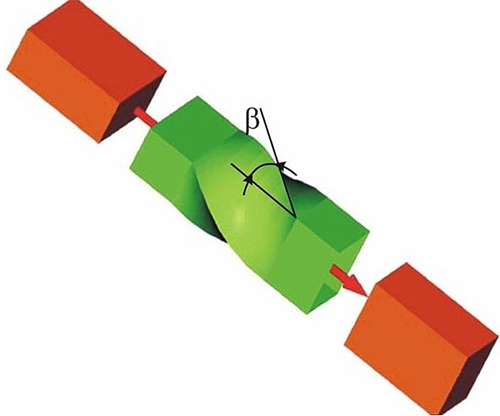Twist Extrusion Processes of Non-Ferrous Alloys
Focus on grain refinement has continued to be a hot topic of material technology and as a known severe plastic deformation (SPD) technique, twist extrusion offers good potential.
Some key benefits of twist extrusion include being able to obtain ultra-fine grain crystalline and nano-crystalline structures and increased plasticity in the alloy.
In the recent years much attention has been paid to the development of ultra-fine grained and nanostructured materials due to their superior properties. Several severe plastic deformation (SPD) techniques have emerged in the recent years for producing ultra fine grained materials in bulk metals and alloys. Among the various SPD techniques, the Twist Extrusion process is used to produce grain refinement in bulk forms.
In comparison with ECAE, TE provides some benefits, such as the ability to extrude hollow parts and rectangular cross-sections. In addition, it is possible to produce more isotropic and homogeneous deformation, by turning the samples through 90° in each consecutive deformation or alternatively, make use of consecutive clockwise-anticlockwise twists. This feature is very important for electronic and magnetic materials. Therefore, the present work has been undertaken to develop fine grained aluminum alloys by twist extrusion process and to examine the microstructure and mechanical properties of twist extruded samples. TE can be applied for a wide range of materials such as Cu, Ti alloys, commercial purity aluminum, Al-Mg alloys, Al-Mg-Si alloys, and Al-Mg-Zn alloys.
This process uses extensive hydrostatic pressure to impose very high strain on bulk solids, producing exceptional grain refinement without introducing any significant change in overall dimensions of the sample. As the specimen is processed, it undergoes severe plastic deformation while maintaining its original cross section. The schematic sketch of twist extrusion process is shown in Figure X.
The twist extrusion principle consists in initiating intensive shear deformation by extruding a billet with rectangular cross section through a die with a twist channel. The channel shape and cross section does not change along the axis of extrusion, while the channel is twisted along this axis. The work-piece shape and cross section does not change as well, which allows repeated extrusion and thus an accumulation of plastic deformation.
The principle of twist extrusion (TE) is shown in Figure 1, in a special closed mold cavity with a helix angle β and a cross-sectional rotation angle α (the cross-section of the spiral channel is always orthogonally with the central axis and remains the unchanged same), shear plastic deformation in the metal billet is generated after twist deformation process, and a "cumulative" strain can be obtained after multi-passes twist extrusion deformation, so a new organization and performance enhancement can be acquired, too. Obviously, the twist rotation angle β and the cross-sectional rotation angle α determine the strength of the strong deformation caused by the twist extrusion (TE), and when the spiral channel length is constant, the twist angle α affects indirectly the helix angle β. Therefore, it is very important to determine and design the optimum twist angle α.

Figure 1: Schematic sketch of Twist Extrusion Process
Features of Twist Extrusion
- The size of the terminating areas of the specimen, that is, the head and rear parts, of the billet, is much smaller under TE than under ECAE, which is especially important when doing repeated runs.
- TE can handle profile billets including those with an axial channel.
- TE can easily be installed on any standard extrusion equipment, by replacing a standard reduction die with a twist die.
- TE (unlike ECAE) does not change the direction of a billet’s movement, which allows TE to be easily embedded into existing industrial lines.
Benefits of Twist Extrusion
There are currently three main benefits of Twist Extrusion:- Obtaining ultra-fine grain crystalline and nano-crystalline structures in bulk specimens
- Increasing the plasticity of secondary non-ferrous metals and alloys, which allows one to significantly broaden the range of production
- Obtaining bulk specimens by consolidating porous materials which allows one to create substantially different new compositions with unique characteristics
Applications of Twist Extrusion
- Aerospace – Engine components (blades, discs, rings and engine cases)
- Airframe components (tail sections, landing gear, wing supports and fasteners)
- Automotive applications - Clamps in locking devices, fasteners in racing bikes
- Medical devices-joint replacement (hip balls and sockets), surgical instruments, wheel chairs, etc.
- Sport products-weight sensitive products, such as high-performance mountain bycicles, tennis rackets.
- Food and chemical industries -Heat exchangers, tanks, process vessels, etc.
Total Materia
Total Materia es la plataforma líder de información sobre materiales, que proporciona la información más amplia sobre propiedades de materiales metálicos y no metálicos y otros registros de materiales.
Toda esta información está disponible en Total Materia Horizon, la herramienta definitiva de información y selección de materiales, que proporciona un acceso inigualable a más de 540.000 materiales, así como datos de referencia actualizados.
Total Materia Horizon incluye:
- Datos exhaustivos sobre propiedades mecánicas y físicas
- >80 normas mundiales y sus equivalencias
- Herramientas de precisión para la comparación y el análisis que agilizan el proceso de selección.
- Datos de tensión-deformación, conformabilidad, fatiga, fluencia y fractura.
- Exportación a más de 25 formatos CAx.
- Información sobre tratamiento térmico, metalografía y corrosión
- Datos de soldadura, soldadura fuerte y adhesivos
- Actualización mensual, fuentes trazables que garantizan la fiabilidad